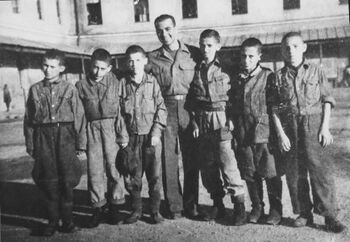Meir Gecht (M / Lithuania, 1929-2011), Holocaust survivor

Meir Gecht / Mejer Hecht (M / Lithuania, 1929-2011), Holocaust survivor.
- KEYWORDS : <Lithuania> <Kovno Ghetto> <Dachau> <Kovno Boys> <Auschwitz> <Death March> <Mauthausen> <Death March> <Gunskirchen>
Biography
Meir Gecht was one of the Kovno Boys, liberated at Gunskirchen.
Meir Gecht (Mejer Hecht) was born August 21, 1929 in Kovno, Lithuania. He was forced to live in the Kovno Ghetto. After the liquidation of the ghetto in 1944 he was sent to Dachau. There he was one of the 131 Kovno Boys who were sent to Auschwitz. With a death march in January 1945 he arrived in Mauthausen on Jan 30, 1945 and then transferred to Gunskirchen. He was part of a group of 37 child survivors from Kovno liberated at Gunskirchen. After the war, he went back to Lithuania wher he reunited with his parents. In 1957 he moved to Poland and the year after to Israel, where he lived in Horon, Israel.
USHMM Oral Interview
- Interview in Hebrew (18 July 1996)
Meir Gecht, born in Kaunus, Lithuania in 1929, describes being an only child; attending a secular Jewish school; the Soviet occupation; German invasion; his father's arrest by Lithuanians (they released him because he was a Lithuanian army veteran); ghettoization; attending a vocational school; his deportation to Stutthof, then Landsberg in July 1944; being separated from his father when he was sent with other children to Dachau; remaining in Dachau for a week and avoiding execution because the crematorium was undergoing repairs; his transfer to Auschwitz/Birkenau; slave labor; a friend arranging to have his number removed from a selection list; a death march and train transfer to Mauthausen; observing cannibalism; a death march to Gunskirchen; abandonment by German guards; walking to Wels, Austria; liberation by United States troops; taking food from German homes; being sent to a displaced persons camp; assistance from the Joint and a Jewish-American soldier; traveling to Budapest, Hungary, then Transylvania; living in a Soviet displaced persons camp; traveling to Orsha, then Vilna; reuniting with his father; learning his mother was alive in the Soviet Union; her arrival in 1946; being drafted into the Soviet military in 1950; serving near Moscow, Russia; discharge in 1954; his marriage to a survivor; the birth of twins; immigrating to Poland, then Israel in 1957 with his parents, wife, and children; the importance of his group of friends to his survival and their annual meetings to the present day; relations between ethnic groups in the camps; the publication in South Africa of his experiences as part of a larger book; and sharing very little of his experiences with his children, not wanting to burden them. He also shows photographs.
Kovno Stories
My name is Meir Gecht, and I was born in Kovno in 1929. My parents were craftspeople. I attended the Reines Jewish school on Zaukasto Street.
When the war broke out we were placed in the ghetto. After the liquidation of the ghetto in 1944, we were sent to the camps. I was separated from my parents in the camps, and did the entire route of the "group of 131".
I was liberated by the American army in Gunskirchen camp on May 5, 1945. After liberation I returned to Lithuania, and to my great luck I found my father, and after a certain while my mother as well.
I served in the Soviet army from 1950 to 1954. After my discharge from the army I returned to Vilna, where I worked in a factory and attended evening classes at a technological college. In 1956 I married Katya, who is also a Holocaust survivor. She hid in the forests during the war and then was in a partisan unit with her older sister.
We immigrated to Poland in 1957, and a year later (1958) we immigrated to Israel.
I worked in the aviation industry until my retirement.